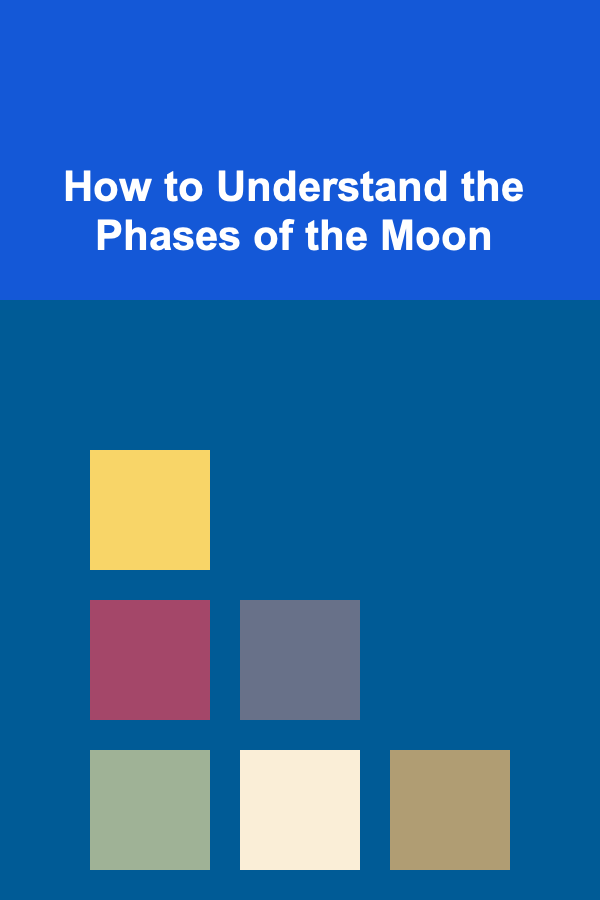
How to Understand the Phases of the Moon
ebook include PDF & Audio bundle (Micro Guide)
$12.99$6.99
Limited Time Offer! Order within the next:

The moon has fascinated humanity for centuries, influencing cultures, science, and even our daily lives. One of the most mesmerizing aspects of the moon is its changing phases, which occur in a predictable cycle. For millennia, people have watched the moon shift from a sliver of light to a full, glowing sphere before retreating into darkness again. But what exactly causes the moon to go through these phases, and how can we understand them? This article delves into the phases of the moon, their causes, significance, and how to recognize them in the night sky.
What Are the Phases of the Moon?
The phases of the moon refer to the different stages the moon goes through as seen from Earth. These stages are due to the moon's orbit around our planet, and the way sunlight illuminates the moon's surface. As the moon orbits Earth, the portion of the moon that is lit by the sun changes, creating the various phases. These phases repeat in a predictable cycle, which lasts approximately 29.5 days, known as a lunar cycle.
The primary phases of the moon are:
- New Moon
- Waxing Crescent
- First Quarter
- Waxing Gibbous
- Full Moon
- Waning Gibbous
- Last Quarter
- Waning Crescent
Each phase plays a role in how we experience the moon's appearance, and understanding the science behind these stages can enhance your appreciation of the night sky.
The Science Behind the Phases
The Moon's Orbit and Position Relative to Earth and the Sun
To understand the phases of the moon, it's crucial to first grasp how the moon moves in relation to Earth and the Sun. The moon orbits Earth in an elliptical path, taking approximately 27.3 days to complete one orbit. However, because Earth is also moving around the Sun, it takes about 29.5 days for the moon to return to the same phase, completing one full lunar cycle.
The moon's surface is illuminated by sunlight, but as it orbits Earth, different portions of the moon are visible. The amount of sunlight that reaches the moon and how much of the moon we can see from Earth changes throughout the month. This is what creates the various phases.
The key factor in the moon's changing phases is its relative position to the Earth and Sun. The moon does not emit its own light; rather, it reflects the light of the Sun. As the moon orbits Earth, we see different amounts of its sunlit side, depending on its position.
The Phases Explained
1. New Moon
The new moon marks the beginning of the lunar cycle. During this phase, the moon is positioned between Earth and the Sun. From Earth, we cannot see the illuminated side of the moon, as the sunlit side is facing away from us. The new moon appears completely dark, and this phase lasts for only a short time.
2. Waxing Crescent
After the new moon, the moon begins to move along its orbit, and a small portion of its illuminated side becomes visible. This phase is known as the waxing crescent, during which the moon appears as a thin crescent shape. The waxing crescent phase occurs as the moon moves away from the Sun, gradually increasing the visible illuminated area.
3. First Quarter
The first quarter occurs roughly one week after the new moon. At this point, the moon has traveled a quarter of the way around Earth. Half of the moon's surface is illuminated, and the other half is in shadow. This creates the half-moon shape that is easily recognizable in the sky. Despite the name "first quarter," the moon is not in the first quarter of its orbit but has reached a quarter of the way through its cycle.
4. Waxing Gibbous
In the waxing gibbous phase, more than half of the moon's surface is illuminated, but it is not yet a full moon. As the moon continues its orbit, more and more of its surface becomes visible. The term "waxing" refers to the increasing visibility of the illuminated portion, while "gibbous" describes the bulging shape.
5. Full Moon
The full moon occurs when the moon is on the opposite side of Earth from the Sun. During this phase, the entire sunlit side of the moon is visible from Earth, creating the bright, round shape that is easily identifiable. The full moon marks the halfway point of the lunar cycle and is often associated with cultural rituals, folklore, and a sense of awe.
6. Waning Gibbous
After the full moon, the illuminated portion of the moon begins to decrease. This is called the waning gibbous phase, during which the moon still appears mostly illuminated, but the light is starting to fade. The moon is now moving closer to the Sun in its orbit, and the amount of visible light decreases gradually.
7. Last Quarter
The last quarter, also known as the third quarter, occurs roughly three weeks after the new moon. The moon is again at a point where half of its surface is illuminated, but the opposite half compared to the first quarter. This phase marks the final stage of the waning moon, and the visible light continues to diminish.
8. Waning Crescent
The waning crescent phase is the final stage before the new moon. During this phase, only a small sliver of the moon is visible, as the moon moves closer to the Sun and its illuminated side becomes less and less visible. The waning crescent is the transition phase between the last quarter and the new moon.
The Lunar Cycle and Calendar
The lunar cycle, or the time it takes the moon to go through all its phases, is approximately 29.5 days. This period is known as a "synodic month," and it is slightly longer than the moon's orbital period of 27.3 days. This difference arises because Earth is also moving around the Sun, so the moon has to travel a bit farther to align with the Sun and Earth for the same phase to occur again.
The lunar cycle is the basis for many traditional calendars. For example, the Islamic calendar is a purely lunar calendar, relying on the phases of the moon to mark months. Some cultures also celebrate important events and festivals based on the phases of the moon, such as the Chinese New Year, which is determined by the lunar calendar.
The Influence of the Moon's Phases
The moon's phases have been a source of cultural significance for centuries. Many ancient civilizations, such as the Egyptians, Babylonians, and Mayans, closely observed the moon's cycle and used it to predict seasons, agricultural cycles, and religious events. Even today, the phases of the moon continue to influence various aspects of modern life, from fishing and farming practices to spiritual and ritual observances.
Tides
One of the most significant effects of the moon's phases is on Earth's tides. The moon's gravitational pull causes the water in Earth's oceans to bulge, creating high and low tides. During the new moon and full moon phases, the gravitational forces of the Sun and moon align, creating the highest and lowest tides, known as spring tides. Conversely, during the first and last quarter phases, when the Sun and moon are at right angles, the tidal range is smaller, known as neap tides.
Human Behavior and Beliefs
Throughout history, the phases of the moon have been linked to various beliefs and myths. Some cultures associate the full moon with increased activity or even mystical occurrences. For example, many people believe that the full moon can influence human behavior, leading to heightened emotions, sleep disturbances, or even strange occurrences. While there is no scientific evidence to support these claims, the full moon remains a powerful symbol in many societies.
How to Observe and Track the Phases of the Moon
Understanding the phases of the moon can enhance your stargazing experience and connect you with the natural rhythms of the sky. There are several ways to observe and track the moon's phases:
- Use a Moon Phase Calendar: Many online resources and apps provide moon phase calendars that can help you keep track of the current phase. These calendars show the exact dates of each phase, making it easy to plan stargazing sessions.
- Watch the Moon Each Night: By observing the moon each night, you can notice the subtle changes in its appearance. Over the course of a month, you'll see the moon transition from a thin crescent to a full moon and back again.
- Moon Apps: There are many smartphone apps that offer detailed information about the moon, including real-time phase tracking and visualizations of how the moon will appear on any given day.
- Photography: Capturing the moon through photography can be a rewarding way to document its phases. Use a camera with a telephoto lens to get clear shots of the moon during different phases, and watch how its appearance changes over time.
Conclusion
The phases of the moon are a fascinating natural phenomenon that has intrigued humanity for thousands of years. Understanding the science behind these phases can deepen your appreciation of the moon and its role in our world. Whether you're an aspiring astronomer, a nature lover, or simply curious about the night sky, observing and tracking the moon's phases can be a rewarding experience. The moon's cyclical nature, influenced by its position relative to Earth and the Sun, reminds us of the beauty and predictability of the universe.

How to Install Acoustic Panels for Maximum Sound Absorption
Read More
How to Plan for a Multi-Stage Home Renovation Project
Read More
How To Reduce Your Risk of Autoimmune Diseases
Read More
How to Create Dynamic Time-Lapse Videos
Read More
Investing in Climate Resilient Infrastructure: A Deep Dive
Read More
How To Use Data to Inform Content Creation
Read MoreOther Products

How to Install Acoustic Panels for Maximum Sound Absorption
Read More
How to Plan for a Multi-Stage Home Renovation Project
Read More
How To Reduce Your Risk of Autoimmune Diseases
Read More
How to Create Dynamic Time-Lapse Videos
Read More
Investing in Climate Resilient Infrastructure: A Deep Dive
Read More